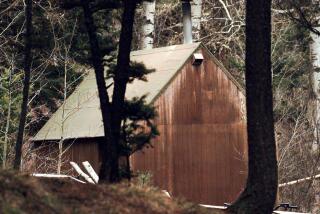Complexity and Chaos: the Mathematics Behind Nature
- Share via
It’s fitting that the man suspected of being the infamous Unabomber is a mathematician. After all, the case has all the markings of two interesting areas of mathematics: chaos theory and complexity.
The former describes how complex systems are easily thrown into chaos by a slight change at the starting point--say, how the flapping of a fly’s wings over Katmandu can cause a tornado next month in Kansas.
The latter describes how the congregation of many simple things can create complex forms--for example, how identical water droplets obeying simple laws of nature can create clouds, snowflakes, rainbows and tornadoes in Kansas.
These two connected mathematical ideas go a long way toward explaining not only how nature makes a Unabomber, but also why it’s so hard to figure out what causes cancer, or what’s behind the seesawing of the stock market.
The development of Ted Kaczynski or any other person depends less on the pieces than how they are arranged; we are all made of the same electrons, protons and neutrons. The arrangement, in turn, is determined by a complex web of influences from the diet of our mother’s mother to the genetic material of our father to the chemicals in his environment to just plain luck.
*
All these influences affect each other in a process known as nonlinear dynamics--when effects add up to much more than the total of their causes, like an avalanche of influences where each pebble and rock tugs on every other pebble and rock on the mountain.
Weather patterns are systems like that, and so are people and communities. You can’t change one piece without pulling the whole thing out of whack. Nonlinearity endlessly complicates the study of every thing from consciousness to heart attacks to the origins of the universe.
Like anyone, the Unabomber was born with certain tendencies toward certain kinds of behavior. But whether those genetic influences have a chance to work, and how they reveal themselves, depends on the environment in which they are planted.
Anthropologist Melvin Konner spins out this whole rich tapestry in his beautiful book “The Tangled Wing: Biological Constraints on the Human Spirit.” In mind-boggling detail, he shows how supposedly hard-wired aspects of ourselves (like brain cells) are shaped by outside forces, and how the outside world we experience is shaped by the senses and thoughts in our heads.
So when a psychologist said to me that she thought the Unabomber’s behavior was driven mainly by his genes, I was highly skeptical. It’s just too difficult to tease out a single strand from this mangled web. Too much, say, like climate modeling.
Climatologists struggling to understand planetary weather systems are stuck in such an endless feedback loop. Everyone knows by now that the carbon dioxide exhaled into our air by cars and factories holds onto heat and could lead to global warming. But green plants breathe in CO2 to live, and may, just possibly, thrive in a high-CO2 atmosphere. If global warming leads to a proliferation of plants, then it could result in global cooling as plants inhale most of the CO2.
*
It’s much the same problem faced by scientists (and increasingly, juries) in trying to tease out causes for health problems, including cancer. No doubt, our environment is rife with cancer-causing substances. But just as surely, everyone knows someone who smoked three packs of cigarettes a day and lives to brag about it. It’s the interplay of all these factors that produces the result.
It just goes to show that nature is more complicated than we are.






